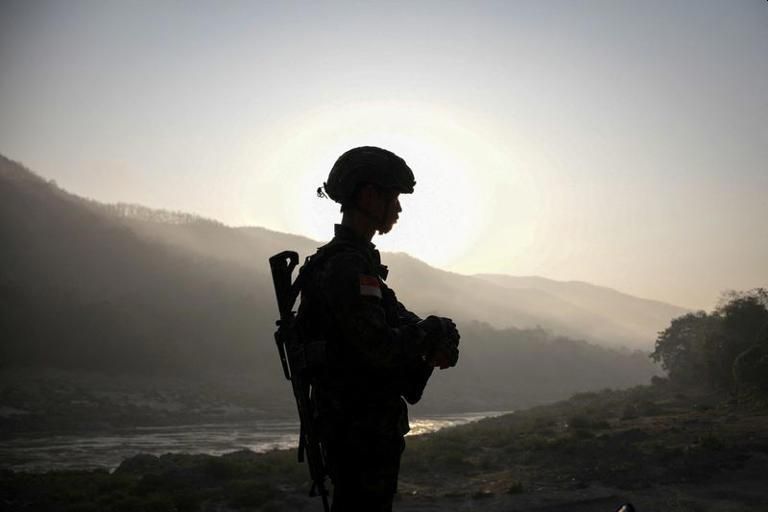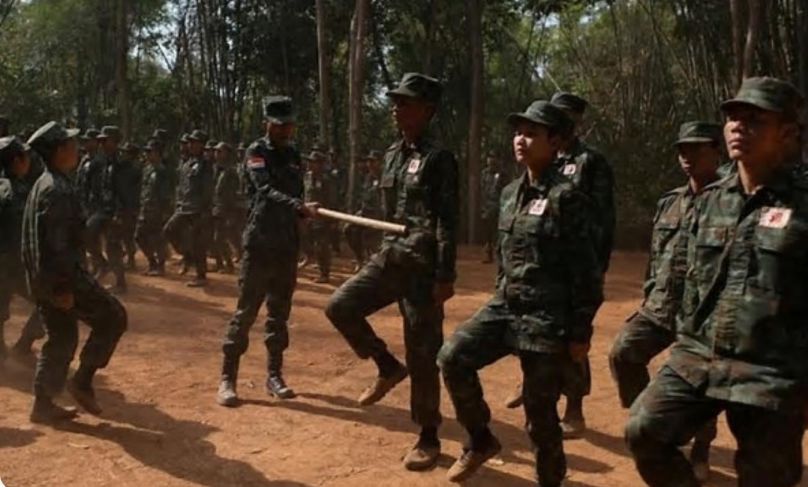By Eric Vandenbroeck and co-workers
Myanmar and Southeast Asia
The term Southeast Asia itself did not exist before the 20th century and was first
established as a regional concept in pre-Japan. First, the region was known to
the Japanese as nanyô, or "South
Seas".
Known for the infamous Burma
Road when the famous `Flying Tigers' flew missions to protect the
Burma Road against the depredations of Japanese fighters.
Besides the An-hsi Protectorate that has already been discussed
in the Tarim Basin, three other zones abutted the Tibetans. In the
Southwest, in Szechwan, the Chien-nan Zone protected the trade road from China
into modern-day Myanmar. The mountainous of the area and its relative
inaccessibility for both sides meant that fewer troops were stationed here.
Every accessible route from Tibet to China was fortified, but there were few
such routes.
world-news-research.com/pastandfuture2.html
The conventional periodization of Burmese history
based on the efforts of early British colonial scholars has
characterized pre-colonial Myanmar as essentially a succession of
warring ethnic states. However, this characterization has
been challenged by more recent scholars.
The Burma Road was to convey supplies to China during
the Second Sino-Japanese War. Preventing
the flow of supplies on the road helped motivate the occupation of Burma by the
Empire of Japan in 1942 during World War II. Use of the road was restored to
the Allies in 1945 after the completion of the Ledo Road. Some parts of the old
road are still visible today.
Rebels have been strikingly successful in an offensive
against the junta in the northern Shan State, which borders China, called
Operation 1027, named for the day it started,
October 27, 2023. The offensive has been led by a coalition of ethnic
armies called the Three Brotherhood Alliance, made up of the Arakan Army,
the Myanmar National Democratic Alliance Army, and the Ta’ang National
Liberation Army.
Part of the existence of these rebel groups is the unworkable nature of federalism in this
multi-ethnic society.
Even after having signed a ceasefire, the Burmese military
continued to attack the Burma Army and the Shan State Progress Party/Shan State
Army-North areas. Since
clashes between the Burma Army and the Shan State Progress Party/Shan State
Army-North broke out in
early October and continued into
early December, more than 10,000 civilians in Mong Hsu, Mong Nong, and Kesi Townships have fled
their homes.
When an alliance led by three rebel armies seized
swathes of territory near Myanmar's border with China from the military junta
last October, Beijing looked the other way.
A year on, rebel forces have ground down the junta,
pushing the military out of vital borderlands and making inroads into the contested heart of Myanmar.
In response, China has
sealed the border and shut off key imports to territory under rebel control,
said a rebel leader and five border-area residents, a move analysts say aims to
dissuade the alliance from further advances, including attacking the cultural
capital of Mandalay.
After initially backing the Three Brotherhood Alliance
to crack down on rampant border crime going unchecked by the junta, Beijing is
increasingly alarmed at the rapid degeneration of the military, which it still
sees as a guarantor of stability in its neighbor, said two analysts who track
Myanmar-China relations. One said that China is also anxious about the
ascendancy of rebel groups that have been helping the alliance and are tied to
the U.S.-backed parallel National Unity Government.
A member of Bamar People's
Liberation Army (BPLA) stands guard in territory belonging to the Karen
National Liberation Army (KNLA), in Karen State, Myanmar, February 18, 2024.

The previously
unreported details of how Beijing is pressuring rebel forces, including by
blocking imports - leading at least one group to withdraw from the fight - were
described to Reuters by nine people with knowledge of the conflict.
One inflection point came in August, when the alliance
took the northeastern town of Lashio, marking the first seizure of a regional
military command in Myanmar's history.
The town of about
130,000 fell to the rebels twice as quickly as they had expected, said Ni Ni Kyaw, secretary of a communist resistance group fighting
in support of Operation 1027, as the alliance-led offensive is known.
Myanmar's junta said
in a statement responding to Reuters' questions that it cooperates with Beijing
to ensure stability and rule of law along the frontier, and will not accept the
demands of "armed terrorists," as it calls the rebels.
"We will continue to solve the situation using
political methods," it said.

China's foreign
ministry told Reuters it "resolutely opposes the emergence of chaos and
war in Myanmar" and urges involved parties to "jointly push for a
soft landing of the situation" near the border. The Chinese consulate in
Mandalay was partially damaged by a blast last week, though there were no
casualties.
Some rebel groups hope to build on the recent momentum
and chart a course south to Mandalay, two rebel leaders and analysts said. From
there, the capital of Naypyidaw is a mere 300km (190 miles) away.
---------------------
Beijing would likely
oppose such a move, said international security expert Zhu Jiangming,
who has written about the border situation for Chinese state media.
"Mandalay is the
second largest city in Myanmar, equivalent to Shanghai," he said, adding
that the fall of Mandalay would be a turning point in the conflict that Beijing
would try to prevent.
'Difficult Situation'
Operation 1027, named
after the date when fighting commenced last year, started at a time when crime
ensnarling Chinese victims was taking place near the border. That prompted
Beijing not to object when the Three Brotherhood Alliance started routing the junta.
The alliance is
composed of three groups - including the ethnic Chinese Myanmar National
Democratic Alliance Army (MNDAA) - over which Beijing has influence but not
direct control.
But China opposes the
collapse of the junta, which ousted Aung San Suu Kyi's civilian government in a
2021 coup. It fears perpetual turmoil along its 1,250-mile border with Myanmar
would jeopardise investments and trade, analysts say.
--------
Cracking down on
crime should not eclipse the bigger picture, Zheng Gang of CITIC Reform and
Development Research Foundation, a division of a Chinese state-owned enterprise
developing a port in Myanmar, wrote in a March analysis.
He said greater
unrest in Myanmar could benefit China’s rivals, including the U.S. and Japan,
whom he said were viewed favourably by influential
groups like the NUG.
Beijing previously
flexed its muscles when it negotiated a ceasefire between some ethnic militias
and the junta in January. But fighting later continued and by mid August, Lashio had fallen.
Shortly after
Lashio's collapse, Chinese foreign minister Wang Yi met junta leader Min Aung
Hlaing in Myanmar. Wang told him Beijing "opposes chaos and
conflicts" and urged him to "safeguard Chinese personnel and
projects," according to a Chinese government readout. China's military
held joint-fire exercises on the border later that month.
Pressure on the Three
Brotherhood Alliance followed. China closed border gates, cutting off supplies
to territory newly under MNDAA control, according to Maung Saungkha,
leader of another army which supported the alliance in the fighting, as well as
five residents.
Even medical supplies
like children's vaccines have not been getting through, leaving the rebels
running a public health system amid conflict "in a very difficult
situation", said Maung Saungkha.
The tightened border
controls have slowed the flow of arms and ammunition to resistance groups, he
said, adding that his forces would try to seize more ammunition from defeated
junta troops.
In September, the
MNDAA, which has longstanding ties with China, declared it would not work with
allies to expand territory, nor engage with or cooperate with “foreign nations”
that opposed China or Myanmar. It also announced it was ready for a ceasefire
under China’s guidance, though it remains part of the alliance.
Late that month, the
junta invited rebel forces to peace talks. The proposal was swiftly rejected by
rebel leaders like Maung Saungkha, who said China's
role in backing such negotiations could pave the way for a sham election.
A senior National
Unity Government official, who spoke on condition of anonymity because they
were not authorised to discuss relations with
Beijing, said China was trying to create divisions among anti-junta forces.
Beijing has urged some groups to stop fighting the military and cease
cooperating with the NUG, said the official, without providing evidence.
The NUG has a loose
alliance with some rebel groups, while others sit within its chain of command.
An assault on
Mandalay would be difficult for the Three Brotherhood Alliance to engage in
while maintaining ties with China, said Jason Tower, an analyst with the
Washington-based U.S. Institute of Peace. He added that it would be risky for
the rebels to try and take Mandalay without alliance backing.
Soe Thuya Zaw, a
commander of the Mandalay People's Defence Forces, which
reports to the NUG, said China’s influence was a “reality," but that
groups like his farther from the border could lead in the fight for
Mandalay.
“We must unite, we
must prepare, and we must do our training to overcome the pressure from China,”
he said.
Instability at the Top
Beijing's latest
intervention came after seeing how quickly junta forces disintegrated in
Lashio.
"China has now
become even more proactive and shifted its posture quite remarkably," said
Tower.
Rebels believed the
junta would use the temporary halt in combat forced by China to prepare a
strong defence there, said Soe Thuya Zaw. Instead,
the military struggled to put up a fight when conflict resumed, with its high
command losing communication with senior officers at regional
headquarters.
There has also been
instability at the top.
Since the 2021 coup,
Min Aung Hlaing has rotated his regional military commanders at a much faster
rate. Between June 2017 and the Feb. 2021 coup, the 14 regional military
commands that form the bedrock of the general's hold over Myanmar saw 36 people
serve as commanders, according to Security Force Monitor, a research group at
Columbia University.
In the same 44-month
period after the coup, there were 49 commanders, an increase of 36%.
Many of the rotations
- the details of which have not been previously reported - occurred in the area
abutting China where the military has lost significant ground.
"According to
the latest data available, the majority of currently serving regional military
commanders have never commanded a regional military command before," said
Tony Wilson, the research group's director.
The quick-fire
rotation of commanders reflected a bid by Min Aung Hlaing to assert greater
control over the military and forestall dissent, said analyst Ye Myo Hein. The
general has come under unprecedented pressure and criticism – even from
loyalists – for the defeats over the past year.
During the rebel
offensive, Min Aung Hlaing sacked Lashio's regional commander for
insubordination after an argument, according to analyst Min Zaw Oo, who has
interacted with junta officials, and Ye Myo Hein.
The replacement was
not able to enter Lashio during the fighting, they said, nor were
reinforcements from other areas.
"You don't change a commander in a crisis just
for insubordination," Min Zaw Oo said.
For updates click hompage here